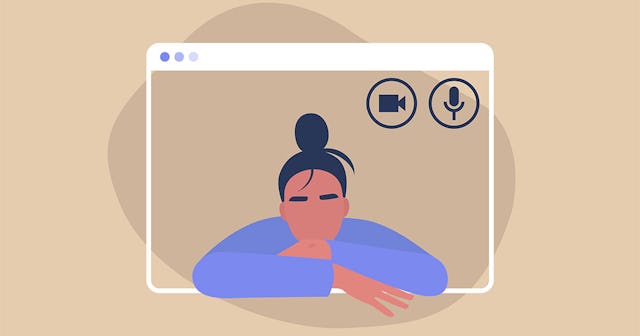Zoom Dysmorphia Is A Thing — And It's Affecting Women More Than Men

Millions of individuals use Zoom. In fact, it is estimated that 300 million people meet on the video conferencing platform each day. Three hundred million. In addition, three million more use Google Meet. 145 million use Microsoft Teams, and millions of others use platforms like Skype, Slack, FaceTime, and WebEx.
I meet with my therapist and psychiatrist virtually. Technology has, in many ways, saved my mental health. But that is not the case for everyone. Spending hours in front of the camera is having an unexpected impact on many, and for some, seeing ourselves — constantly and consistently — is negatively impacting our mental health.
“My appearance was taking greater and greater hits and the worse I got, the more I was staring at the video of myself on the screen,” Becky Schwarz, a 27-year-old operations manager from Washington, recently told The Guardian. “Zoom has made me want to be invisible, but that is incredibly lonely,” Schwarz added. “I’m really not sure how to come out the other side of this.”
Schwarz is not alone. According to a recent study published by the International Journal of Women’s Dermatology, instances of body dysmorphic disorder, or BDD, have risen during the course of the pandemic and both social media and videoconferencing are to blame.
“Increased time spent videoconferencing, using social media, and using filters on these platforms during the pandemic has led to worsening self-perception and mental health, especially in younger aged females,” the study states. And in some cases this has to ‘Zoom dysmorphia,’ an unofficial mental health condition in which people see a distorted image of themselves, one which causes a distressing response.
“Zoom dysmorphia refers to a type of BDD known as facial dysmorphia,” Psychology Today explains. “Those who suffer from this condition scrutinize their noses, skin, teeth, ears and other aspects of their faces, fixating on what they think needs to change and avoiding social interactions.” Being on-screen exacerbates their symptoms, and they often see things which are not there.
“Seeing themselves on a computer screen is like looking into a funhouse mirror and believing the distorted image reflects reality,” the article adds. It can cause severe anxiety and stress. Some individuals isolate, shut down, and/or withdraw.
“Increased time spent on video calls with our own image reflected at us has led many to experience increased feelings of self-consciousness and body dissatisfaction, as well as greater pressure to change our appearance in some way,” the clinical staff at The Renfrew Center, the first residential eating disorder treatment facility in the United States, tells Scary Mommy. “Those who suffer from body image issues are most prone to seeing themselves through this lens of self-criticism, which may lead to disordered eating, overexercise, or a desire to seek cosmetic procedures, also known [unofficially] as Zoom dysmorphia.” In short, being in front of the camera is causing some severe mental and emotional distress. Video calls are disrupting their lives.
Of course, dysmorphic disorders are not new. BDD, or body dysmorphic disorder, is a mental health disorder in which you can’t stop thinking about one or more perceived defects or flaws in your appearance, and Zoom-induced dysmorphia is no different. People with dysmorphia feel intense shame, Psychology Today explains. They are embarrassed by their “fault” and “flaws,” and people with dysmorphia go to intense lengths to alter their appearance.
I lived with BDD for several years and starved myself “pretty.” I worked out obsessively and ate no more than 800 calories a day, subsisting on black coffee and baby food — and I still wasn’t happy. Even when my BMI was well below 20. I picked my body apart, pulling at the “skin flaps” on my stomach and poking and prodding my thighs.
The good news (for me) is that I was able to throw the scale away. I hid from the mirror while I healed, but those experiencing Zoom dysmorphia aren’t as lucky, especially if the video conferencing platform is a mandatory part of their job.
Sam, a 28-year-old data analyst from Toronto, told The Guardian he experienced intrusive thoughts for years, but when the pandemic hit and work went online, he started to fixate on perceived flaws about single facial features. “I began constantly stopping at mirrors or reflective surfaces to confirm whether the facial feature actually aligned with my mental image of it,” he said. On Microsoft Teams, he found himself “mirror checking” all day.
Ultimately, Sam got a nose job.
“I was pleased with the results for a few months but later, the dysmorphia re-emerged, and I found a new flaw in the same facial feature,” Sam added. “I’m now on the waitlist for a therapist with body dysmorphic disorder expertise.”
That said, there are things you can do to manage your symptoms.
“If Zoom seems to be worsening BDD, it might be helpful to adjust the Zoom settings to hide your own image,” Samantha DeCaro, the assistant clinical director at The Renfrew Center of Philadelphia, tells Scary Mommy. “Cognitive behavioral therapy, or CBT, can also help those with BDD, as it helps them understand how certain thoughts intensify distress and certain avoidance behaviors maintain the cycle… and exposure therapy can be beneficial. A qualified therapist can help you gradually increase your exposure to your perceived flaws, so that over time they have less and less power over you.”
This article was originally published on